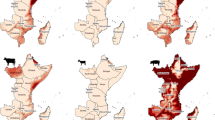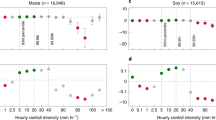Abstract
Animal-level responses to weather variability in US dairy systems are well described, but the potential of housing and other farm management practices (for example, fans and sprinklers) to moderate the impacts of weather remains uncertain. Here we assess the influence of historical variation in the temperature–humidity index (THI) on milk yields using monthly state-level yield data and high-resolution daily weather data over 1981–2018. We find that milk yields are compromised by exposure to both extreme heat (>79 THI) and cold (<39 THI), causing average daily yield decreases of around 3.7% and 6.1%, respectively, relative to optimal conditions (65–69 THI). Colder regions are more sensitive to heat extremes, and warm regions are more sensitive to cold extremes. Sensitivity to THI has reduced dramatically over time. Climate trends contributed modestly (around 0.1% over 38 years) to rising yields in most states via alleviating cold stress, although more extreme future conditions may negate these benefits.
This is a preview of subscription content, access via your institution
Access options
Access Nature and 54 other Nature Portfolio journals
Get Nature+, our best-value online-access subscription
$29.99 / 30 days
cancel any time
Subscribe to this journal
Receive 12 digital issues and online access to articles
$119.00 per year
only $9.92 per issue
Buy this article
- Purchase on Springer Link
- Instant access to full article PDF
Prices may be subject to local taxes which are calculated during checkout





Similar content being viewed by others
Data availability
USDA data on monthly milk yields and dairy cow populations are publicly available from USDA NASS Quickstats (https://quickstats.nass.usda.gov/). Weather data from PRISM are also publicly available (https://prism.oregonstate.edu/). In addition, compiled datasets utilized for the findings of this study are available on Zenodo with the identifier https://doi.org/10.5281/zenodo.4818011.
Code availability
Code utilized for the findings of this study is available on Zenodo with the identifier https://doi.org/10.5281/zenodo.4818011.
References
Dairy Production and Products: Milk and Milk Products (FAO, 2013); http://www.fao.org/dairy-production-products/production/dairy-animals/cattle/en/
Background: Corn and Other Feedgrains (USDA ERS, 2018); https://www.ers.usda.gov/topics/animal-products/dairy/background/
National Agricultural Statistics Service (US Department of Agriculture); https://www.nass.usda.gov/index.php
Capper, J. L., Cady, R. A. & Bauman, D. E. The environmental impact of dairy production: 1944 compared with 2007. J. Anim. Sci. 87, 2160–2167 (2009).
Niles, M. T. & Wiltshire, S. Tradeoffs in US dairy manure greenhouse gas emissions, productivity, climate, and manure management strategies. Environ. Res. Commun 1, 075003 (2019).
Field, T. G. & Taylor, R. E. Scientific Farm Animal Production: An Introduction, Eleventh Edition (Pearson, 2018).
Fuquay, J. W. Heat stress as it affects animal production. J. Anim. Sci. 52, 164–174 (1981).
St-Pierre, N. R., Cobanov, B. & Schnitkey, G. Economic losses from heat stress by US livestock industries. J. Dairy Sci. 86, E52–E77 (2003).
Kadzere, C. T., Murphy, M. R., Silanikove, N. & Maltz, E. Heat stress in lactating dairy cows: a review. Livest. Prod. Sci. 77, 59–91 (2002).
Bouraoui, R., Lahmar, M., Majdoub, A., Djemali, M. & Belyea, R. The relationship of temperature–humidity index with milk production of dairy cows in a Mediterranean climate. Anim. Res. 51, 479–491 (2002).
West, J. W. Effects of heat-stress on production in dairy cattle. J. Dairy Sci. 86, 2131–2144 (2003).
Vitali, A. et al. Seasonal pattern of mortality and relationships between mortality and temperature–humidity index in dairy cows. J. Dairy Sci. 92, 3781–3790 (2009).
Pragna, P. et al. Heat stress and dairy cow: impact on both milk yield and composition. Int. J. Dairy Sci. 12, 1–11 (2017).
Hoffmann, I. Climate change and the characterization, breeding and conservation of animal genetic resources. Anim. Genet. 41, 32–46 (2010).
Qi, L., Bravo-Ureta, B. E. & Cabrera, V. E. From cold to hot: a preliminary analysis of climatic effects on the productivity of Wisconsin dairy farms. AgEconSearch https://doi.org/10.22004/ag.econ.172411 (2014).
Bohmanova, J., Misztal, I. & Cole, J. B. Temperature–humidity indices as indicators of milk production losses due to heat stress. J. Dairy Sci. 90, 1947–1956 (2007).
Field, C. B. et al. Managing the Risks of Extreme Events and Disasters to Advance Climate Change Adaptation (IPCC, 2021); https://www.ipcc.ch/report/managing-the-risks-of-extreme-events-and-disasters-to-advance-climate-change-adaptation/
Mueller, N. D. et al. Cooling of US Midwest summer temperature extremes from cropland intensification. Nat. Clim. Chang. 6, 317–322 (2016).
Seneviratne, S. I., Donat, M. G., Mueller, B. & Alexander, L. V. No pause in the increase of hot temperature extremes. Nat. Clim. Chang. 4, 161–163 (2014).
Dairy 2014: Dairy Cattle Management Practices in the United States, 2014 (USDA, APHIS, NAHMS, 2016); https://www.aphis.usda.gov/animal_health/nahms/dairy/downloads/dairy14/Dairy14_dr_PartI_1.pdf
Mondaca, M. R. & Cook, N. B. Modeled construction and operating costs of different ventilation systems for lactating dairy cows. J. Dairy Sci. 102, 896–908 (2019).
Ferreira, F. C., Gennari, R. S., Dahl, G. E. & De Vries, A. Economic feasibility of cooling dry cows across the United States. J. Dairy Sci. 99, 9931–9941 (2016).
Hayhoe, K. et al. Emissions pathways, climate change, and impacts on California. Proc. Natl Acad. Sci. USA 101, 12422–12427 (2004).
Klinedinst, P. L., Wilhite, D. A., Hahn, L. G. & Hubbard, K. G. The potential effects of climate change on summer seasonal dairy cattle milk production and reproduction. Clim. Chang. 23, 21–36 (1993).
Mauger, G., Bauman, Y., Nennich, T. & Salathé, E. Impacts of climate change on milk production in the United States. Prof. Geogr. 67, 121–131 (2015).
Key, N. & Sneeringer, S. Potential effects of climate change on the productivity of U.S. dairies. Am. J. Agric. Econ. 96, 1136–1156 (2014).
Ortiz-Bobea, A., Knippenberg, E. & Chambers, R. G. Growing climatic sensitivity of U.S. agriculture linked to technological change and regional specialization. Sci. Adv. 4, eaat4343 (2018).
Butler, E. E., Mueller, N. D. & Huybers, P. Peculiarly pleasant weather for US maize. Proc. Natl Acad. Sci. USA 115, 11935–11940 (2018).
Lobell, D. B., Schlenker, W. & Costa-Roberts, J. Climate trends and global crop production since 1980. Science 333, 616–620 (2011).
Tigchelaar, M., Battisti, D. S., Naylor, R. L. & Ray, D. K. Future warming increases probability of globally synchronized maize production shocks. Proc. Natl Acad. Sci. U. S. A. 115, 6644–6649 (2018).
PRISM Climate Data (Oregon State Univ., 2019); http://www.prism.oregonstate.edu/
Daly, C. et al. Physiographically sensitive mapping of climatological temperature and precipitation across the conterminous United States. Int. J. Climatol. https://doi.org/10.1002/joc.1688 (2008).
National Research Council. Nutrient Requirements of Dairy Cattle, Seventh Revised Edition (National Academies Press, 2001).
Auldist, M. J., Walsh, B. J. & Thomson, N. A. Seasonal and lactational influences on bovine milk composition in New Zealand. J. Dairy Res. 65, 401–411 (1998).
Lobell, D. B. Climate change adaptation in crop production: beware of illusions. Glob. Food Sec. 3, 72–76 (2014).
Mukherjee, D., Bravo-Ureta, B. E. & De Vries, A. Dairy productivity and climatic conditions: econometric evidence from South-eastern United States. Aust. J. Agric. Resour. Econ. 57, 123–140 (2013).
Milk Cost of Production Estimates: Cost-of-Production Estimates-2016 Base (USDA ERS, 2021); https://www.ers.usda.gov/data-products/milk-cost-of-production-estimates/milk-cost-of-production-estimates/#Milk
Liang, X. Z. et al. Determining climate effects on US total agricultural productivity. Proc. Natl Acad. Sci. USA 114, E2285–E2292 (2017).
Malikov, E., Miao, R. & Zhang, J. Distributional and temporal heterogeneity in the climate change effects on U.S. agriculture. J. Environ. Econ. Manage. 104, 102386 (2020).
MacDonald, J. M., Law, J. & Mosheim, R. Consolidation in U.S. Dairy Farming Economic Research Report No. 274 (ERS, USDA, 2020); https://www.ers.usda.gov/publications/pub-details/?pubid=98900
Hemme, T. & Otte, J. Pro-Poor Livestock Policy Initiative Status and Prospects for Smallholder Milk Production a Global Perspective (Food and Agriculture Organization of the United Nations, 2010).
Osei-Amponsah, R. et al. Heat stress impacts on lactating cows grazing Australian summer pastures on an automatic robotic dairy. Animals 10, 869 (2020).
Chang-Fung-Martel, J., Harrison, M. T., Rawnsley, R., Smith, A. P. & Meinke, H. The impact of extreme climatic events on pasture-based dairy systems: a review. Crop Pasture Sci 68, 1158 (2017).
Livestock Hot Weather Stress. Operations Manual (NOAA, 1976); https://scirp.org/reference/referencespapers.aspx?referenceid=1913216
Pinheiro J., Bates D., Debroy S. S. D. Linear and nonlinear mixed effects models, R package nlme version 3.1-152 (2021).
Conley, T. G. GMM estimation with cross sectional dependence. J. Econom. 92, 1–45 (1999).
Borchers, H. W. pracma: practical numerical math functions, version 2.2.9.1–393 (2019).
Colin Cameron, A., Gelbach, J. B. & Miller, D. L. Robust inference with multiway clustering. J. Bus. Econ. Stat. 29, 238–249 (2011).
Zeileis, A., Köll, S. & Graham, N. Various versatile variances: an object-oriented implementation of clustered covariances in R. J. Stat. Softw. https://doi.org/10.18637/jss.v095.i01 (2020).
Acknowledgements
The authors thank S. Davis, L. Sloat and J. Dillon for helpful comments. This work is supported by the Interdisciplinary Engagement in Animal Systems Program (2021-68014-34141 to N.D.M.) from the USDA National Institute of Food and Agriculture.
Author information
Authors and Affiliations
Contributions
N.D.M., M.G.-Q. and A.H. designed the study. M.G.-Q. and A.H conducted the analyses with support from N.D.M. and B.M. on the analytical framework and interpretation of model results, A.J.R. on weather data processing and E.K. and M.T.N. on interpretation regarding dairy cattle physiology and management. M.G.-Q., N.D.M. and A.H. led the writing with input from all co-authors.
Corresponding authors
Ethics declarations
Competing interests
The authors declare no competing interests.
Additional information
Peer review information Nature Food thanks Michelle Tigchelaar, Matthew Harrison and the other, anonymous, reviewer(s) for their contribution to the peer review of this work.
Publisher’s note Springer Nature remains neutral with regard to jurisdictional claims in published maps and institutional affiliations.
Supplementary information
Supplementary Information
Supplementary Methods, Figs. 1 and 2 and Tables 1–11.
Rights and permissions
About this article
Cite this article
Gisbert-Queral, M., Henningsen, A., Markussen, B. et al. Climate impacts and adaptation in US dairy systems 1981–2018. Nat Food 2, 894–901 (2021). https://doi.org/10.1038/s43016-021-00372-z
Received:
Accepted:
Published:
Issue Date:
DOI: https://doi.org/10.1038/s43016-021-00372-z
This article is cited by
-
Unequal impact of climate warming on meat yields of global cattle farming
Communications Earth & Environment (2024)
-
Phosphorus applications adjusted to optimal crop yields can help sustain global phosphorus reserves
Nature Food (2024)
-
Silver lining to a climate crisis in multiple prospects for alleviating crop waterlogging under future climates
Nature Communications (2023)
-
Climate change benefits negated by extreme heat
Nature Food (2021)



